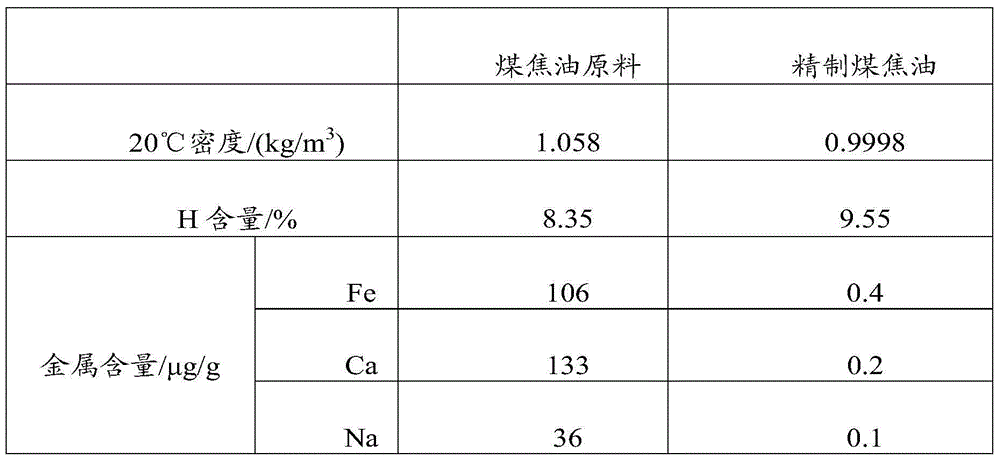Coal tar hydrogenation pretreatment catalyst and preparation method thereof
A technology of hydrotreating pretreatment and catalyst, applied in refining to remove heteroatoms, etc., can solve the problems of low removal rate, inability to meet subsequent deep hydrogenation feed, waste of resources, etc. Long, high metal removal effect
- Summary
- Abstract
- Description
- Claims
- Application Information
AI Technical Summary
Problems solved by technology
Method used
Image
Examples
Embodiment 1
[0041]Take 141.0 g of macroporous dry rubber powder, add 3.0 g of scallop powder, 2.5 g of borax (analytical pure), and mix well. Dissolve 8.0g of commercially available PVA1788 powder in 115mL of water under stirring and heating slowly. After the dissolution is complete, add it to the above-mentioned uniformly mixed dry rubber powder. Strips, the extruded strips were dried at 120°C for 5 hours, baked at 550°C for 3 hours, and then taken out, which was designated as carrier A.
[0042] Take 4.01g of molybdenum oxide (AR), 1.40g of basic nickel carbonate (AR), 0.81g of concentrated phosphoric acid (AR), add 100mL of water, continue to heat and reflux under stirring, stop heating after the solution becomes transparent, and cool down to room temperature for later use. Take 80 g of carrier sample A and impregnate it by the pore saturation method. After impregnation, let it air in a fume hood for 3 hours, then dry it at 120° C. for 3 hours, and bake it in a muffle furnace at 350° C...
Embodiment 2
[0044] Take 141.0 g of macroporous dry rubber powder, add 3.0 g of scallop powder, 2.5 g of boric acid (analytical pure), and mix well. Dissolve 8.0g of commercially available PVA1788 powder in 115mL of water under stirring and heating slowly. After the dissolution is complete, add it to the well-mixed dry rubber powder. , the extruded strips were dried at 120°C for 5 hours, then calcined at 550°C for 3 hours and then taken out to obtain a carrier.
[0045] Take 4.01g of molybdenum oxide (AR), 1.40g of basic nickel carbonate (AR), 0.81g of concentrated phosphoric acid (AR), add 100mL of water, continue to heat and reflux under stirring, stop heating after the solution becomes transparent, and cool down to room temperature for later use. Take 80 g of the carrier, impregnate it by pore saturation method, after impregnation, let it air in the fume hood for 3 hours, dry it at 120°C for 3 hours, and bake it in a muffle furnace at 350°C for 20 hours to obtain the catalyst.
Embodiment 3
[0047] Take 141.0 g of macroporous dry rubber powder, add 3.0 g of starch, 2.5 g of borax (analytical pure), and mix well. Dissolve 8.0g of commercially available PVA1788 powder in 115mL of water under stirring and heating slowly. After the dissolution is complete, add it to the well-mixed dry rubber powder. , the extruded strips were dried at 120°C for 5 hours, then calcined at 550°C for 3 hours and then taken out to obtain a carrier.
[0048] Take 4.01g of molybdenum oxide (AR), 1.40g of basic nickel carbonate (AR), 0.81g of concentrated phosphoric acid (AR), add 100mL of water, continue to heat and reflux under stirring, stop heating after the solution becomes transparent, and cool down to room temperature for later use. Take 80 g of the carrier, impregnate it by pore saturation method, after impregnation, let it air in the fume hood for 3 hours, dry it at 120°C for 3 hours, and bake it in a muffle furnace at 350°C for 20 hours to obtain the catalyst.
PUM
| Property | Measurement | Unit |
|---|---|---|
| dew point | aaaaa | aaaaa |
| specific surface area | aaaaa | aaaaa |
| crystallinity | aaaaa | aaaaa |
Abstract
Description
Claims
Application Information
 Login to View More
Login to View More - R&D
- Intellectual Property
- Life Sciences
- Materials
- Tech Scout
- Unparalleled Data Quality
- Higher Quality Content
- 60% Fewer Hallucinations
Browse by: Latest US Patents, China's latest patents, Technical Efficacy Thesaurus, Application Domain, Technology Topic, Popular Technical Reports.
© 2025 PatSnap. All rights reserved.Legal|Privacy policy|Modern Slavery Act Transparency Statement|Sitemap|About US| Contact US: help@patsnap.com

